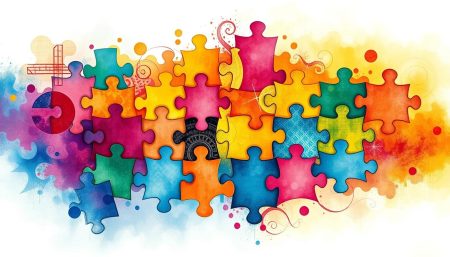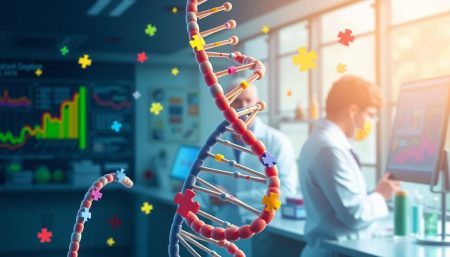Autism Spectrum Disorder (ASD) is a range of conditions that affect how people communicate and behave. It’s known for its social challenges, repetitive actions, and unique strengths. The term “spectrum” shows how different each person with ASD can be.
Before, ASD was seen as many separate conditions. But now, we understand it as a spectrum. This view helps us see the many ways ASD can affect people.
By seeing ASD as a spectrum, we can offer better support. This approach helps families and professionals help each person in their own way. Let’s dive into the world of ASD together, learning more about its many sides.
What is Autism Spectrum Disorder?
Autism Spectrum Disorder (ASD) is a complex condition that affects people differently. It shows through various symptoms and abilities. Understanding it is key for creating personalized support and help.
Defining Autism Spectrum Disorder
The Centers for Disease Control and Prevention (CDC) says ASD includes many conditions. These are marked by challenges in social skills, repetitive behaviors, speech, and nonverbal communication. There are several types of ASD, each with its own autism spectrum classifications and ASD categories.
The Spectrum: Explaining the Range
The Autism Society notes that the autism spectrum is very wide. Symptoms vary greatly in type and severity. This spectrum includes Asperger’s syndrome, pervasive developmental disorders, and autistic disorder. These categories help in creating specific strategies for each person’s needs and abilities.
It’s important to understand the wide range of autism. Each person with autism has their own strengths and challenges. Knowing the different categories helps in planning better treatments and support.
Early Signs and Diagnosis of Autism
Spotting the early signs of autism spectrum disorder (ASD) is key. It helps in getting a diagnosis early. This leads to better support and care for children with autism.
Recognizing Early Signs in Infants and Toddlers
From birth to 36 months, kids go through big changes. These changes can show if a child might have ASD. Parents should watch for signs like not making eye contact, not pointing or gesturing, and not talking much.
They should also notice if a child doesn’t want to play with others. These signs might mean a child has autism and needs a doctor’s check-up.
The Diagnostic Process for ASD
Diagnosing autism takes a team effort. Doctors, psychologists, and neurologists all play a part. Autism Speaks says it’s important to do a full check-up.
This might include watching how the child acts, asking questions, and sometimes testing their genes. The aim is to help each child in their own way. This is because autism can look different in every child.
Types of Autism Spectrum Disorder
Autism Spectrum Disorder (ASD) includes many developmental conditions. Each has its own challenges and traits. Knowing the types of ASD and autistic spectrum variations helps professionals, caregivers, and society support those affected.
Classic Autism: Understanding Autistic Disorder
Classic autism, once called autistic disorder, is the more severe type. It’s marked by big language delays, social and communication issues, and odd behaviors. It’s usually spotted in young kids. People with classic autism need a lot of help with everyday tasks and social interactions.
Asperger’s Syndrome: A Unique Form on the Spectrum
Asperger’s Syndrome is on the milder side of the spectrum. It’s known for its less severe symptoms compared to classic autism. People with Asperger’s often have a deep interest in certain topics, are very smart, and have a big vocabulary. Yet, they might find it hard to understand social cues and handle social situations, which can make personal relationships and communication tough.
- Persistent difficulties in social communication.
- Restricted, repetitive patterns of behavior, interests, or activities.
- Typically diagnosed in later childhood or adolescence.
Different Forms of Autism
Looking into the autism spectrum types and ASD subtypes shows a wide range of conditions. Each has its own set of challenges and symptoms. The World Health Organization (WHO) and the National Institute of Neurological Disorders and Stroke (NINDS) help us understand this by categorizing them.
Understanding the ASD subtypes helps us provide better support and interventions. Here, we outline some key categories based on behavior and developmental impacts of autism spectrum types.
| ASD Subtype | Characteristics |
|---|---|
| Autistic Disorder | Known for significant language delays, social and communication challenges, and unusual behaviors and interests. |
| Asperger’s Syndrome | Milder symptoms mostly involving social challenges without significant delays in language or cognitive development. |
| Pervasive Developmental Disorder – Not Specified (PDD-NOS) | Marked by milder symptoms that do not fully conform to the criteria of other ASD subtypes. |
This summary shows the varied forms within autism spectrum types. It stresses the need for a personalized approach in managing and understanding autism.
High-Functioning Autism: Traits and Challenges
The term high-functioning autism is often used for those on the autism spectrum without an intellectual disability. But this label is misleading. It doesn’t show the complex high-functioning autism characteristics and ASD challenges they face. Research from the Autism Research Institute and Yale University’s Yale Developmental Disabilities Clinic highlights their unique traits and hurdles.
Navigating a Life with High-Functioning Autism
People with high-functioning autism often have great memory and attention to detail. But, their skills can hide social and sensory issues, common in ASD challenges. Simple tasks like talking, understanding emotions, and handling surprises can be hard.
The Misconception of High Functioning
Many think ‘high-functioning’ means life is easy without support. But, this is far from true. Many need structured support to manage their high-functioning autism characteristics. They struggle with emotions, planning, and keeping relationships, affecting their life quality.
- Enhanced cognitive skills juxtaposed with social communication difficulties.
- Need for routine and structured environments to reduce anxiety and stress.
- Disparity between intellectual capabilities and adaptive behaviors.
It’s key to understand these complex issues to offer the right support. This helps clear up myths about high-functioning autism.
Rett Syndrome: A Rare Genetic Mutation
Rett Syndrome is a rare condition that mainly affects girls. It causes severe problems with motor skills and speech. It’s different from other autism spectrum disorders because of its unique genetic and symptoms.
This disorder is caused by a mutation on the X chromosome in a gene called MECP2. This gene is key for brain development. The mutation is usually spontaneous, not passed down from parents.
Research by the National Organization for Rare Disorders (NORD) and the Rett Syndrome Research Trust has made big strides. They’ve learned a lot about the molecular and cellular mechanisms of Rett Syndrome. This knowledge is important for creating new treatments.
| Symptoms | Age of Onset | Progression |
|---|---|---|
| Loss of motor skills | 6-18 months | Rapid |
| Slowed growth | 6-18 months | Gradual |
| Loss of speech abilities | 12-24 months | Progressive |
| Abnormal hand movements | 12-24 months | Intermittent through childhood |
The symptoms of Rett Syndrome show a loss of skills after early milestones. Knowing about Rett Syndrome helps us understand the different ways autism can show up. It’s key to raising awareness and understanding of this complex condition.
Childhood Disintegrative Disorder (CDD)
Childhood Disintegrative Disorder, or CDD, is a rare autism spectrum type. It is known for its late start in developmental delays. These delays happen in language, social skills, and motor skills. The American Academy of Child & Adolescent Psychiatry says it usually starts around 3-4 years old, after a normal start.
Childhood Disintegrative Disorder is different because it involves a big step back in skills. This can include losing motor skills, getting worse at talking, and struggling more with social interactions. Because it’s so rare, it’s hard to diagnose and treat.
- Initial developmental progress similar to peers
- Sudden regression in multiple developmental areas
- Significant impact on communication and social interactions
MedlinePlus gives us the details on how to diagnose and manage CDD. It shows how important it is to have a team of experts. This team should include psychologists and teachers who can help with special education. As we learn more, we can offer better support to families.
| Age of Onset | Typical Development Before Regression | Areas of Regression |
|---|---|---|
| 3-4 Years | Yes | Language, Social, Motor Skills |
| 5-6 Years | Limited Cases | Social Skills and Communication |
In conclusion, Childhood Disintegrative Disorder is tough, but we’re getting better at understanding and helping it. This shows we need to keep researching and learning about all autism spectrum types.
Autism Spectrum Classifications: DSM-5 Changes
The American Psychiatric Association released the Diagnostic and Statistical Manual of Mental Disorders, Fifth Edition (DSM-5). This change has greatly impacted how we understand and diagnose autism. The DSM-5 autism spectrum changes have updated the ASD diagnostic criteria. This affects clinical approaches and patient support.
Understanding the Shift in Autism Classifications
The DSM-5 has merged several diagnoses into Autism Spectrum Disorder (ASD). This change views autism as a spectrum with varying severity levels. It includes disorders once seen as separate. The goal is to offer more accurate diagnoses and personalized treatments.
Impact of DSM-5 on Diagnosis and Support
The DSM-5 changes focus on the severity and support needs of individuals. The new criteria look at social communication and repetitive behaviors. These updates show a deeper understanding of ASD’s diverse forms.
| Criteria | DSM-IV | DSM-5 |
|---|---|---|
| Number of Core Areas | Three | Two |
| Categories | Autistic Disorder, Asperger’s Syndrome, PDD-NOS | Autism Spectrum Disorder |
| Severity Assessment | Not Specified | Levels 1, 2, 3 (Requiring support, substantial support, very substantial support) |
| Focus on Sensory Issues | No | Yes, explicitly listed |
Autism Variations within the Spectrum
Exploring autism spectrum disorder (ASD) shows us how different it can be for each person. Conditions like ADHD and anxiety, along with gender differences, shape how we diagnose and treat ASD.
The Role of Comorbid Conditions in Autism
Many people with ASD also have other conditions like ADHD and anxiety. These conditions make diagnosis and treatment harder. A team approach is needed to manage these complex needs.
Gender Differences in Autism Expression
Research shows that autism looks different in boys and girls. This affects how we diagnose and support them. It’s important to understand these differences to help everyone with autism.
| Condition | Prevalence in Males | Prevalence in Females |
|---|---|---|
| ADHD | High | Moderate |
| Anxiety | Moderate | High |
| Sensory Sensitivities | Common | Very Common |
It’s key to understand the many ways autism can present. This helps us create better treatments that meet each person’s needs. By doing so, we can improve lives for those on the autism spectrum.
Autism in Adults: Late Diagnosis and Support
Understanding adult autism diagnosis is key, as it often goes unnoticed until later in life. This is due to the many types of ASD. Getting a diagnosis as an adult can impact work, relationships, and self-awareness. That’s why ASD support for adults is so important.

Adults diagnosed with autism face unique challenges and benefits. Knowing they have autism can bring relief and understanding of past struggles. But, they also need specialized support made just for adults, different from what kids get.
- Increased awareness about one’s own identity and behaviors
- Access to tailored therapies and interventions
- Easier access to community and online groups focused on autism
But, living with autism without the right ASD support for adults can be tough. Important services include career advice, relationship coaching, and mental health care that gets adult autism diagnosis.
Groups like Autism Speaks and the Autistic Self Advocacy Network are key. They provide resources that educate and empower adults. With education, workplace help, and peer support, adults with types of ASD can find success and happiness.
- Identify necessary accommodations in the workplace
- Provide platforms for social connection and support
- Foster understanding through continuous education on ASD
The talk about autism in adults is growing. It shows we need a better way to understand and support adults with autism. This approach should reflect their real-life experiences.
ASD Subtypes: A Closer Look
Autism Spectrum Disorder (ASD) includes a wide range of neurodevelopmental conditions. Each subtype has its own unique characteristics and challenges. Pervasive Developmental Disorder – Not Specified (PDD-NOS) is one such subtype that is often misunderstood.
Pervasive Developmental Disorder – Not Specified (PDD-NOS)
PDD-NOS is a part of ASD and is used for those who don’t fit into other autism categories. It helps those who are close but not quite there. Yet, its less clear definition can also cause confusion.
People with PDD-NOS often struggle with using nonverbal behaviors like eye contact and facial expressions. These issues make social interactions hard. But, unlike other ASD subtypes, symptoms in PDD-NOS can vary a lot. This makes it tricky to find the right treatment.
| Feature | PDD-NOS | Other ASD Subtypes |
|---|---|---|
| Diagnostic Criteria | Less stringent | More specific |
| Symptom Consistency | Variable | Consistent |
| Intervention Strategies | Highly individualized | Standardized based on subtype |
Learning about PDD-NOS helps us understand ASD better. It shows the need for specific treatments and care. This knowledge helps educators and therapists create better plans for those with PDD-NOS. It proves that each person needs a unique approach to support their needs.
Treatment and Therapies for Different Types of ASD
Looking into autism spectrum treatments means combining behavioral therapies and educational strategies. These methods support individuals in a holistic way. Tailored approaches are key to effective intervention.
Behavioral Therapies and Interventions
Behavioral therapies are at the heart of autism spectrum treatments. They aim to improve social, communication, and learning skills. The American Occupational Therapy Association says therapies like Applied Behavior Analysis (ABA) are very effective.
- ABA (Applied Behavior Analysis)
- Cognitive Behavioral Therapy (CBT)
- Social Skills Training
- Occupational Therapy
Educational Strategies and Support Systems
Educational support is vital in both regular and special schools. Each student gets a plan that fits their needs. This helps create a better learning space.
- Individualized Education Programs (IEP)
- Inclusive Classroom Strategies
- Visual Supports and Technology Aids
- Collaborative Team Teaching (CTT)
Creating a supportive educational setting helps students succeed academically and socially. The National Institute of Child Health and Human Development stresses the need for adaptive tools and resources.
| Therapy Type | Targeted Skill Development | Common Techniques |
|---|---|---|
| ABA | Communication, Social Skills | Task Analysis, Positive Reinforcement |
| CBT | Emotion Regulation | Cognitive Restructuring, Exposure Response Prevention |
| Social Skills Training | Interaction Skills | Role-Playing, Group Activities |
| Occupational Therapy | Sensory and Motor Skills | Sensory Integration, Fine Motor Activities |
Together, these treatments and strategies form a strong support system. They help individuals on the autism spectrum live better lives and improve their social skills.
Autistic Spectrum Variations and Family Dynamics
Understanding the different autism spectrum variations helps us see how they affect families. Families dealing with autism face unique challenges. These can change a lot depending on the type of autism.
Every type of autism has its own set of behaviors, ways of communicating, and how they interact with others. For example, a family with a child who has high-functioning autism might face different challenges than one with more severe autism. This affects how the family works together, what support they need, and how they use resources.
- Emotional toll on family members
- Adjustment to routine and specialized care resources
- Financial implications of therapies and educational support
The ASD family impact goes beyond daily tasks. It affects the family’s emotional and mental health. Organizations like Autism Research and Resources of Oregon and the Family Resource Center on Disabilities offer important help. They provide resources to manage these impacts well.
To support a family with autism, it’s key to understand the different autism spectrum variations and their effects. Tailored support can help overcome challenges. It can also improve the life quality of all family members.
Technological Advances in Understanding ASD
Autism Spectrum Disorder (ASD) is changing fast, thanks to new technology. This tech helps doctors diagnose ASD more accurately. It also leads to new ways to treat it. With technology, doctors can make treatments fit each person better, helping them more.
How New Tech Improves Diagnosis and Treatment
New tech is changing how we diagnose and treat ASD. The Massachusetts Institute of Technology (MIT) Media Lab is at the forefront. They’ve created AI tools that can spot ASD early and accurately.
This means kids can get help sooner. It’s a big step forward in treating ASD.
The Future of Tech-Assisted Autism Care
The future of ASD care looks bright with technology. Wearable tech can track anxiety in kids with ASD. It alerts others when a child is upset, helping them calm down faster.
This tech makes everyday life easier for kids with ASD. It also improves their overall quality of life.
The future of ASD diagnosis and treatment is looking up. New tech is making treatments more personal and effective. As these technologies get better, they will help us understand and manage ASD even more.
Global Perspectives on Autism Spectrum Types
How we understand and treat Autism Spectrum Disorder (ASD) changes a lot from one culture to another. These differences show us the global autism perspectives. They are influenced by culture, economy, and healthcare. By looking at these views, we can find common challenges and chances to improve international ASD treatment plans.
Cultural Views on Autism
Looking into cultural views of ASD shows a wide range of beliefs and practices. In some places, ASD is linked to social stigma. In others, it’s viewed as a special variation needing special care. Groups like Autism-Europe push for a unified understanding. They want to respect cultural differences while promoting global best practices.
International Approaches to Therapies and Support
The international ASD treatment scene has many therapy and support methods. In the U.S., there are structured, insurance-based approaches. In Africa and Asia, there are family and community-focused methods. This variety comes from different healthcare levels and training, as the World Health Organization (WHO) points out.

- United States and Europe: Well-established autism support systems with many behavioral and developmental therapies.
- Asia: Growing awareness and treatment methods that consider social and family contexts.
- Africa: New support frameworks with a big focus on community involvement.
This global look highlights the varied cultural views of ASD. It also shows why working together is key to better ASD support worldwide. This could lead to a more inclusive future for those with ASD globally.
Advocacy and Acceptance of People with Autism
The push for autism spectrum advocacy and ASD acceptance has grown a lot in recent years. This is thanks to groups like the Autism Self Advocacy Network. They help change the focus from just awareness to acceptance and empowerment.
They fight for the rights of those with autism. They make sure their voices are heard in important decisions. This includes policy and services that affect their lives.
The United Nations also plays a big role. They celebrate World Autism Awareness Day to highlight the need for understanding and support. This shows that the world is working together towards acceptance.
These efforts are key for the well-being of those with autism and for society. When we accept everyone, people with autism can grow and share their talents. The journey towards acceptance is ongoing. With education, talking openly, and action, we can create a world where everyone is valued.
FAQ
Q: What is Autism Spectrum Disorder?
A: Autism Spectrum Disorder (ASD) is a developmental disorder. It affects how people communicate and behave. The impact can vary greatly, from needing a lot of support to living mostly independently.
Q: Can you explain the range of the autism spectrum?
A: The autism spectrum includes a wide range of challenges and abilities. It covers those with severe impairments who may not speak to those with mild symptoms who face social communication challenges. This is why it’s called a spectrum disorder.
Q: What are some early signs of autism in infants and toddlers?
A: Early signs of autism include limited eye contact and not responding to their name. They also include repetitive movements and delayed speech and language skills. Parents and caregivers often notice these signs in the first two years.
Q: How is Autism Spectrum Disorder diagnosed?
A: Diagnosing ASD involves a combination of parent interviews and developmental screenings. It also includes tests of speech, intelligence, and social and emotional development.
Q: What are the different types of Autism Spectrum Disorder?
A: The DSM-5 has merged all autism disorders into one diagnosis of ASD. This includes Autistic Disorder, Asperger’s Syndrome, Childhood Disintegrative Disorder, and Pervasive Developmental Disorder – Not Specified.
Q: How does high-functioning autism differ from other forms of ASD?
A: High-functioning autism is an informal term for those on the autism spectrum who can read, write, and manage basic life skills. Their challenges mainly lie in social interaction and communication.
Q: What is Rett Syndrome?
A: Rett Syndrome is a rare genetic mutation affecting brain development, mainly in girls. It’s often mistaken for autism but has distinct symptoms like slowed growth and coordination problems. It’s considered a separate condition from ASD.
Q: What is Childhood Disintegrative Disorder (CDD)?
A: Childhood Disintegrative Disorder is a rare condition where a child develops normally for at least two years. Then, they rapidly lose social, language, and motor skills. It was once recognized as a separate condition within ASD.
Q: How have the autism spectrum classifications changed in recent years?
A: The DSM-5, released in 2013, merged all autism subcategories into a single diagnosis of autism spectrum disorder. This change aimed to improve diagnosis consistency and reduce confusion from previous multiple disorder designations.
Q: What are some common comorbid conditions associated with autism?
A: Common comorbid conditions with autism include ADHD, anxiety disorders, epilepsy, sleep disorders, and Tourette syndrome. Gastrointestinal problems are also common.
Q: Are there gender differences in autism spectrum disorders?
A: Yes, autism is diagnosed more often in males than females. Females with autism may show less apparent symptoms. This can lead to underdiagnosis or misdiagnosis with other conditions.
Q: What challenges do adults with autism face?
A: Adults with autism may struggle with social communication and finding employment and living arrangements. They may also face challenges in accessing healthcare services that meet their needs. A late diagnosis can impact self-understanding and access to supportive resources.
Q: What is Pervasive Developmental Disorder – Not Specified (PDD-NOS)?
A: PDD-NOS was a diagnosis for individuals who didn’t meet full criteria for autistic disorder or Asperger’s Syndrome but showed significant social and communication challenges. The DSM-5 has absorbed this category into the broader ASD diagnosis.
Q: What treatments and therapies are available for ASD?
A: Many treatments and therapies are available for ASD. These include behavioral therapies like Applied Behavior Analysis (ABA), educational strategies, speech therapy, physical therapy, and sometimes medication to manage symptoms.
Q: How does technology contribute to understanding and treating ASD?
A: Technology offers new ways to diagnose and support ASD, from communication apps to virtual reality for social skills training. It also provides data for research and customizes learning, improving quality of life.
Q: What are the international perspectives and approaches to treating ASD?
A: Approaches to treating ASD vary worldwide, reflecting cultural beliefs and healthcare systems. Some focus on inclusive education, while others emphasize specialized services. International efforts aim to share best practices and ensure equal access to care.
Q: Why is advocacy and acceptance important for individuals with autism?
A: Advocacy and acceptance are key for ensuring individuals with autism have the rights and support they deserve. Acceptance helps create a more inclusive society that values neurodiversity and offers equal opportunities for people with autism to thrive.


















